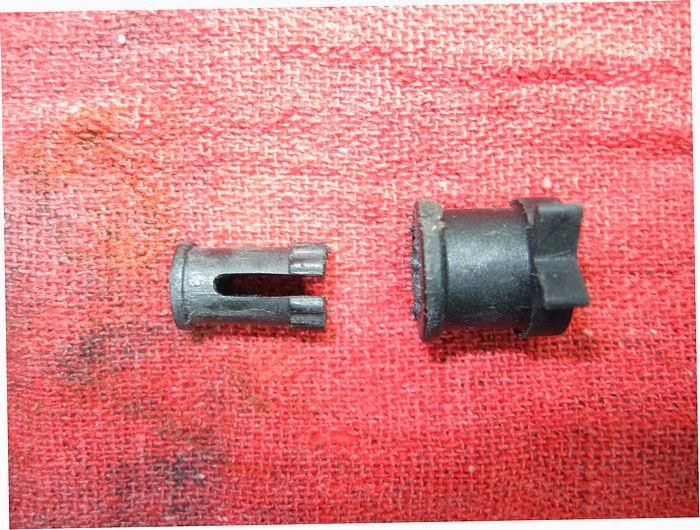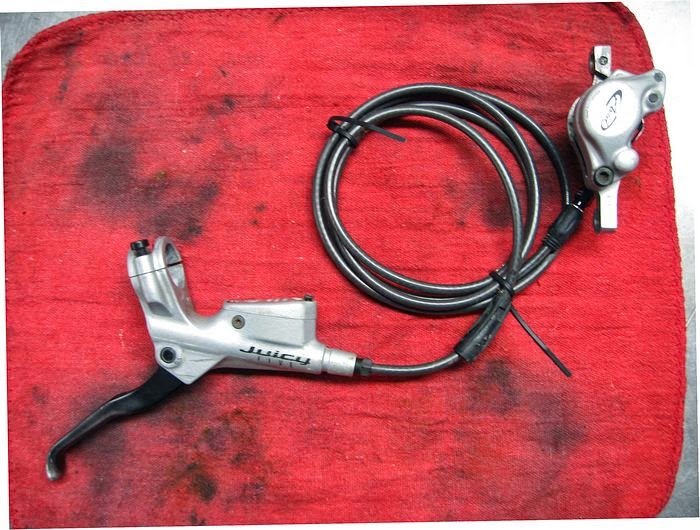Hydraulic Brakes. Make Them Like New Again.
Hydraulic Brakes are one of those components that everyone wants to have and then, when things go wrong, they bail and become anti fluid and pro cable actuated. I will admit that there are some good cable actuated discs out there that are very good, the Avid BB7 for instance, however, nothing comes close to the feel and operation of a good hydraulic system. That is why it is a shame when people ditch them. Even some bike shops are more than happy to sell the hydro's but don't want to mess with them afterwards for service. A hydraulic brake system can be ordered as a kit, hoses attached and filled with fluid. You can always tell a system that has come this way as it will have 3 feet of extra hose in a big loop off the bar, just waiting to be snagged by a passing Moose or even a tree limb. Now sometimes this is just laziness on the part of the mechanic but often it is fear of cracking the system open. So here is a little primer on the hydraulic disc brake system...
I have already mentioned Avid above, apart from making the BB7 they also make some great hydraulic units, the older Juicy and Code plus the newer series of Elixir and Trail. All of these models are easy to service and durable apart from working very well. Shimano also make a range that are popular and again easy'ish to service and repair. Other companies that we are fans of are Formula and Hope, both of these produce disc systems that also qualify as works of art, sadly they also have price tags similar to a minor work from Rembrandt...
So, back to my point. What do you do when things start to go sideways? Well you service them. Below I have taken some pictures of the complete internals of a set of Avid Juicy levers and calipers. These brakes recently came to us from a customer at the Lake of the Ozarks and they were in dire need of some TLC. These brakes are very common but basically all hydraulic brake units are following the same principles, so with a spec sheet of your particular make and model you will be in good shape.
These particular units had developed one of the common issues of older neglected sets. They had developed the sticky lever syndrome. Another common issue is a soft lever which means air is in the system either through the need of a good bleed or the hose has developed a hole or an o ring has failed on a bleed port. The sticky lever however means that the internal plunger in the lever is in need of replacing or that the caliper pistons are beginning to stick and corrode. My rule is, do both, if one end is gummed up and failing the other ain't far behind.
Wear gloves as DOT fluid is not something you want to be bathing in all afternoon and a pair of safety glasses, you would be amazed at how often I have shot myself in the face with a full syringe of this stuff.
I usually start with the lever first and, with a new bag of the correct internals, start cracking it apart. Below is what you end up with, again this is a Juicy so you will have a different looking pile of bits, but they will be doing the same job.
Once the lever blade is removed it will reveal the circlip that needs to be removed to slide out the reach adjust mechanism and the plunger.
The main culprit of the sluggish lever return is the plunger unit, in the above picture it is the thing with the spring attached to it. However when you are pulling it apart you may as well replace all the bits as they are all in the rebuild kit anyway.
Waiting to be cracked open like a walnut...
Once the lever is rebuilt I attack the caliper. Again disconnect the hose first. The only way to get into the pistons is to split the caliper body in half. this is achieved by undoing the three bolts. Once you have the body in two the fun begins. The way to get the pistons out of their press fit home is with the use of compressed air. You cannot get them out any other way so don't be jamming screwdrivers in there or you will damage the body itself and you will get fluid leaking out and the whole unit will become a paperweight. The compressed air does a great job of popping them out. Warning: Make sure you don't have the thing aimed at anything soft and fleshy, it will hurt...
The main culprits in here are the quad rings (the square edged rubber washers) and the round pistons.All of which will be replaced.
Once the caliper has been rebuilt all that is left is to run new hose, to the correct length as mentioned earlier to avoid lassoing stray Moose... Also never re-use banjo fittings or crush washers. Once they have been tightened up they have to be replaced. That's it, job done. Go ride.






